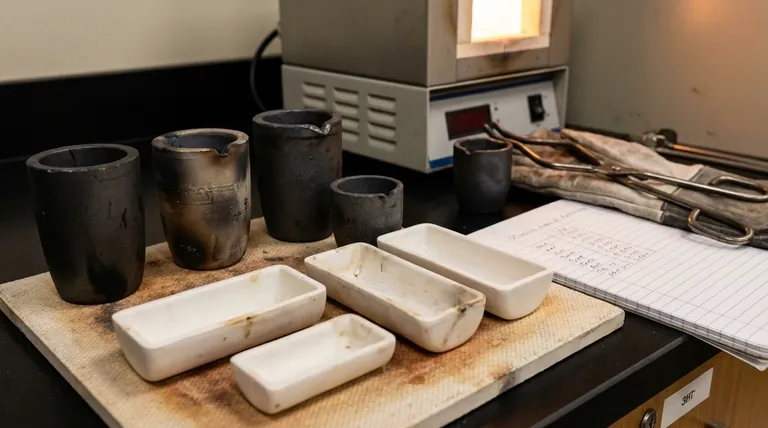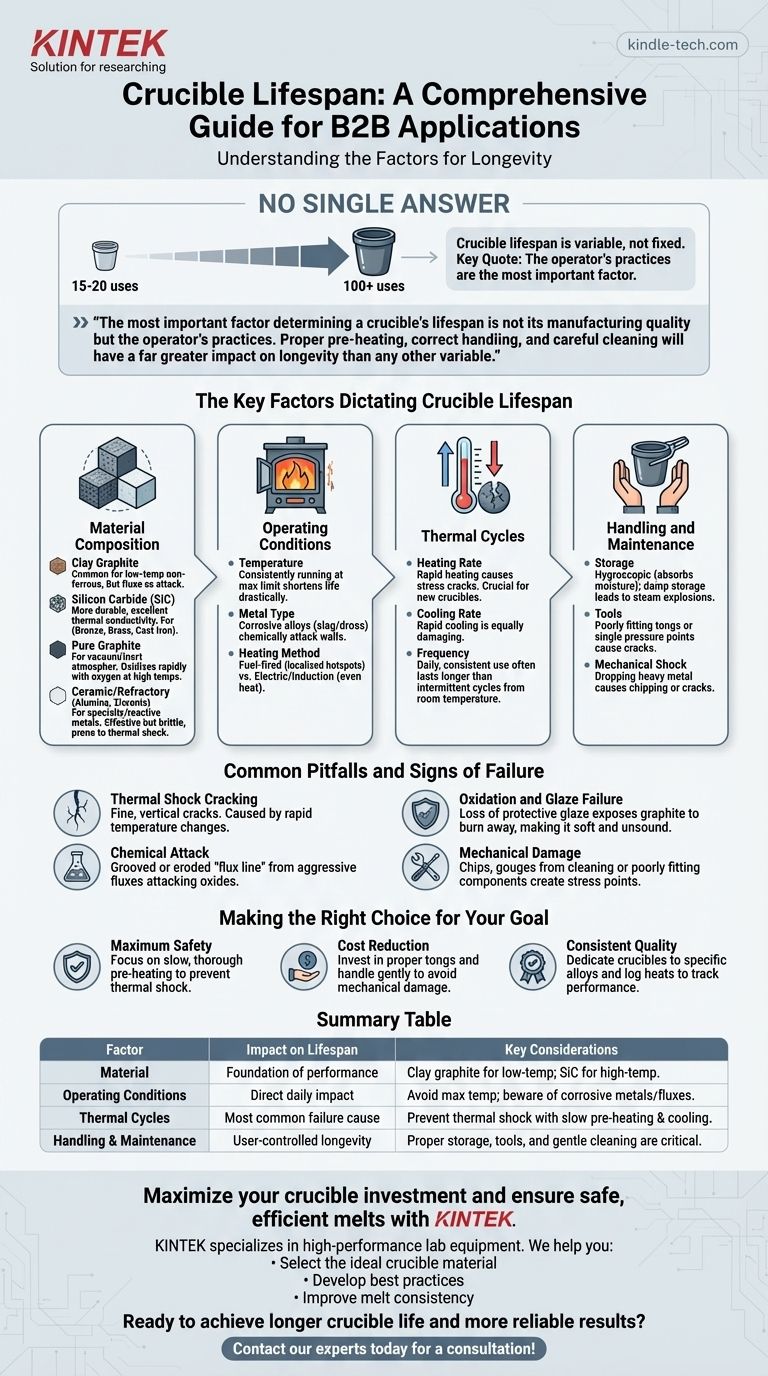There is no single answer to a crucible's lifespan; it can range from as few as 15-20 uses to well over 100. A crucible's longevity is not a fixed attribute but is instead determined by its material, the temperatures it endures, and, most critically, how you handle and maintain it.
The most important factor determining a crucible's lifespan is not its manufacturing quality but the operator's practices. Proper pre-heating, correct handling, and careful cleaning will have a far greater impact on longevity than any other variable.

The Key Factors Dictating Crucible Lifespan
Understanding why a crucible fails is the first step toward extending its life. The process is a balance of four key elements.
Material Composition
The type of crucible you use is the foundation of its performance. Each is designed for specific metals and temperature ranges.
- Clay Graphite: These are a common and cost-effective choice for lower-temperature non-ferrous metals like aluminum, zinc, and brass. They are durable but can be susceptible to aggressive fluxes.
- Silicon Carbide (SiC): More expensive but significantly more durable and long-lasting than clay graphite. SiC crucibles offer excellent thermal conductivity and are suitable for higher-temperature alloys like bronze, brass, and even cast iron.
- Pure Graphite: Primarily used in vacuum or inert atmosphere furnaces. When exposed to oxygen at high temperatures, they oxidize (burn away) rapidly.
- Ceramic/Refractory: Materials like alumina, zirconia, and magnesia are used for specialty applications, high-temperature scientific work, or when melting highly reactive metals. They can be very effective but are often brittle and prone to thermal shock.
Operating Conditions
The environment inside your furnace is incredibly harsh, and how you manage it directly impacts the crucible.
- Temperature: Consistently running a crucible at the upper end of its rated temperature limit will drastically shorten its life.
- Metal Type: Some alloys produce more corrosive slag or dross than others, which can chemically attack the crucible walls.
- Heating Method: Fuel-fired furnaces (propane, natural gas) can create localized hot spots from direct flame impingement, which is harder on a crucible than the even, radiant heat of an electric resistance or induction furnace.
Thermal Cycles
The most common killer of any crucible is thermal shock—the stress induced by rapid temperature changes.
- Heating Rate: Bringing a crucible up to temperature too quickly will cause stress cracks. This is especially true for the first firing of a brand-new crucible.
- Cooling Rate: Allowing a crucible to cool too rapidly can be just as damaging.
- Frequency of Use: A crucible used daily and kept consistently warm will often last longer than one used intermittently, as it endures fewer stressful heating and cooling cycles from room temperature.
Handling and Maintenance
This is the area where you have the most control. Poor handling can destroy a brand-new crucible in a single use.
- Storage: Crucibles are hygroscopic, meaning they absorb moisture from the air. Storing them in a damp environment can lead to steam explosions and cracking on the first heat.
- Tools: Using poorly fitting tongs that pinch the top rim or create a single pressure point can easily crack a hot, softened crucible.
- Mechanical Shock: Dropping heavy ingots or scrap into the crucible can cause chipping or cracks.
Common Pitfalls and Signs of Failure
Being able to recognize the early signs of wear allows you to prevent catastrophic failure, which can damage your furnace and pose a significant safety risk.
Thermal Shock Cracking
This often appears as a fine, vertical crack. It is caused by heating or cooling the crucible too quickly. A gentle pre-heat is the single best preventative measure.
Chemical Attack
Aggressive fluxes are designed to clean metal, and they do so by attacking oxides—including the materials that make up your crucible. This often appears as a grooved or eroded "flux line" around the top of the molten metal, which thins and weakens the crucible wall.
Oxidation and Glaze Failure
Many silicon carbide and clay graphite crucibles have a protective glaze. If this glaze is chipped or worn away, the graphite within the crucible walls can be exposed to oxygen and burn away. The crucible will become soft, "punky," and structurally unsound.
Mechanical Damage
Look for chips, gouges from cleaning tools, or abrasion marks from poorly fitting furnace components. Any point of physical damage becomes a stress concentration point where a crack is likely to form.
Making the Right Choice for Your Goal
Extending crucible life is about developing a consistent, disciplined process. Your specific priority will determine where you should focus your efforts.
- If your primary focus is maximum safety: Your non-negotiable step is a slow, thorough pre-heating protocol for every single use to prevent thermal shock, the leading cause of sudden failure.
- If your primary focus is cost reduction: Invest in properly sized tongs that grip the bottom third of the crucible and train yourself to handle it gently to avoid mechanical damage.
- If your primary focus is consistent, high-quality melts: Dedicate specific crucibles to specific alloys to prevent cross-contamination, and log the number of heats on each one to track performance and predict replacement.
Ultimately, a crucible's lifespan is a direct reflection of the care and respect with which it is treated.
Summary Table:
| Factor | Impact on Lifespan | Key Considerations |
|---|---|---|
| Material | Foundation of performance | Clay graphite for low-temp metals; SiC for high-temp alloys |
| Operating Conditions | Direct daily impact | Avoid max temperature; beware of corrosive metals/fluxes |
| Thermal Cycles | Most common failure cause | Prevent thermal shock with slow pre-heating & cooling |
| Handling & Maintenance | User-controlled longevity | Proper storage, tools, and gentle cleaning are critical |
Maximize your crucible investment and ensure safe, efficient melts with KINTEK.
Whether you're melting aluminum, bronze, or specialty alloys, using the right crucible and proper techniques is crucial for safety and cost-effectiveness. KINTEK specializes in high-performance lab equipment and consumables, including a full range of crucibles designed for specific applications and metals.
We help you:
- Select the ideal crucible material (clay graphite, silicon carbide, ceramic) for your specific metal and temperature requirements.
- Develop best practices for pre-heating, handling, and maintenance to dramatically extend crucible life.
- Improve melt consistency and prevent costly furnace damage from crucible failure.
Ready to achieve longer crucible life and more reliable results? Contact our experts today for a personalized consultation on your lab's melting needs!
Visual Guide

Related Products
- Alumina Al2O3 Ceramic Crucible Semicircle Boat with Lid for Engineering Advanced Fine Ceramics
- Engineering Advanced Fine Ceramics Alumina Al2O3 Crucible With Lid Cylindrical Laboratory Crucible
- Engineering Advanced Fine Ceramics Alumina Crucibles (Al2O3) for Thermal Analysis TGA DTA
- Arc-Shaped Alumina Ceramic Crucible High Temperature Resistant for Engineering Advanced Fine Ceramics
- Engineering Advanced Fine Alumina Al2O3 Ceramic Crucible for Laboratory Muffle Furnace
People Also Ask
- How many times can you use a crucible? Maximize Lifespan and Ensure Safety
- What are the safety precautions of a crucible? Protect Your Lab from Thermal Shock and Hazards
- What temperature can alumina crucible withstand? A Guide to High-Temperature Stability and Safety
- How is a crucible used in the crucible? Unpacking Arthur Miller's Powerful Metaphor
- What needs to be checked before using a crucible? A Guide to Safe and Effective High-Temperature Work



















